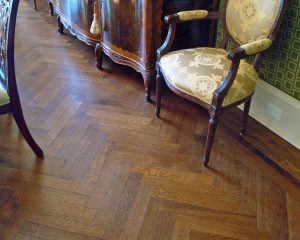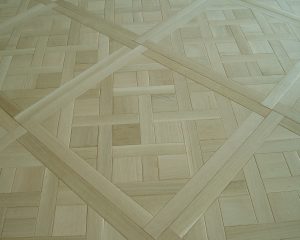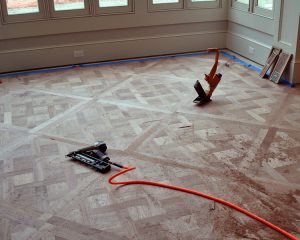 There are, no doubt, as many variations of patterned flooring as there are wood species. Wood floors began for entirely utilitarian purposes. For those wealthy enough in the fifteenth century, second floors were added with planks laid across the joists as flooring. It proved far better than the earthen floor, so often the choice, of the first floor – the ‘ground’ floor. The wood floor soon moved downstairs.
There are, no doubt, as many variations of patterned flooring as there are wood species. Wood floors began for entirely utilitarian purposes. For those wealthy enough in the fifteenth century, second floors were added with planks laid across the joists as flooring. It proved far better than the earthen floor, so often the choice, of the first floor – the ‘ground’ floor. The wood floor soon moved downstairs.
The first wooden floors in colonial America were wide, thick planks harvested from old-growth forests. During the Colonial Era, it was common to use rough-sawn wide planks on the main floor. Most of these floors were from unfinished old growth pine and longleaf heart pine boards; although, for practicality, whatever species of wood readily available was used. Over time, foot traffic added a smooth, venerable patina to the floor.
Later in the fifteenth century, during the Baroque era, wood floors became both utilitarian and decorative. Function gave way to form. Matching and contrasting wood species were used to create borders and patterns within the floor.
By the early nineteenth century, patterned floors were beginning to show up in finer homes. Wooden plank floors remained the most common, but by now parquetry and other patterned floors were growing in popularity. The earliest floors had hand-painted patterns. Later, this gave way to intricate wood patterns.
Parquetry is the method of arranging pieces of wood in geometric patterns. Parquetry comes from the old French ‘parchet’, literally meaning “a small enclosed space“. Fabrication was labor-intensive, as each piece had to be cut and fitted by hand. To smooth the floor surface, the entire floor was scraped and planed by hand, then varnished or waxed.
Many patterned floors were prefabricated into panels; the panels would be fitted together on site to create a finished wood floor. Framed squares, known as Parquet de Versailles, were introduced in 1684 as parquet de menuiserie (“woodwork parquet“).
 Today, many of the older patterns remain in vogue. Herringbone, chevron, Parquet de Versailles, and variations on these patterns are used in grand spaces and finer homes. We specialize in traditional parquetry and custom patterned flooring in a wide range of wood species, grades and cuts. Presently Quarter-sawn white oak and American black walnut are the most popular for floor traditional parquetry. For more information about patterned wood flooring, visit us online at: www.theWoodCo.com.
Today, many of the older patterns remain in vogue. Herringbone, chevron, Parquet de Versailles, and variations on these patterns are used in grand spaces and finer homes. We specialize in traditional parquetry and custom patterned flooring in a wide range of wood species, grades and cuts. Presently Quarter-sawn white oak and American black walnut are the most popular for floor traditional parquetry. For more information about patterned wood flooring, visit us online at: www.theWoodCo.com.
